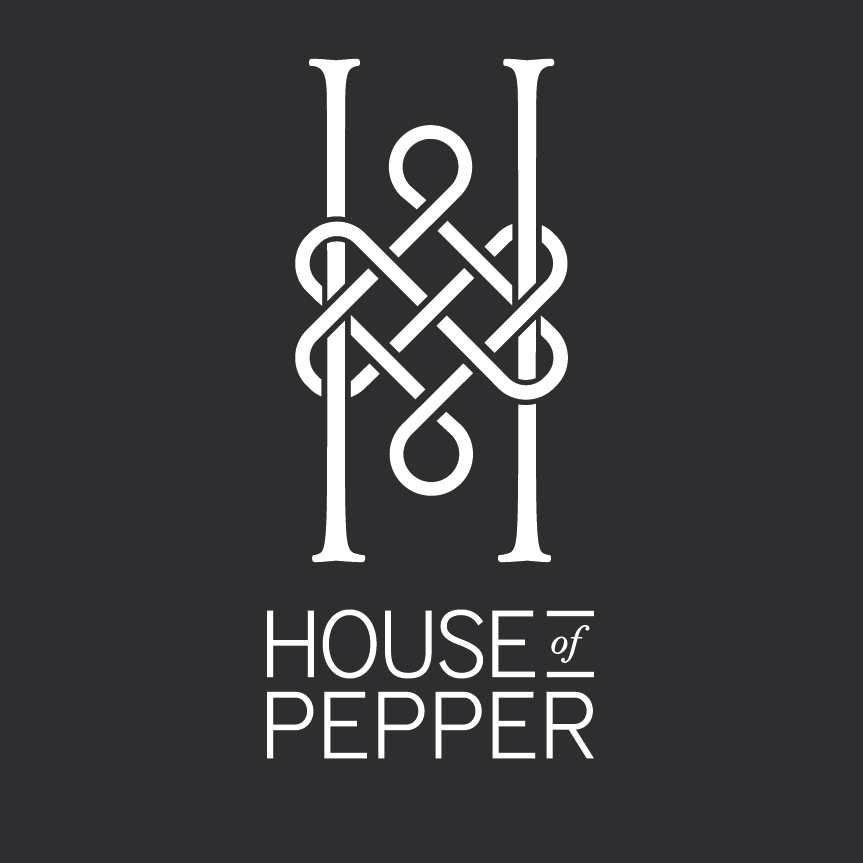The Great Beasts and the Gripping Beasts of Viking art mark an incredible moment in the imaginative mind of an artist. Today, like the great Viking longship they surely are a memorable art icon. They are an indicator of how much muscle power artists have in cooking up the memory of a time and culture gone by. These Viking Norse artists stand out and it is no wonder that the Celtic monk artists of the golden manuscript era of 800 AD were influenced by them.
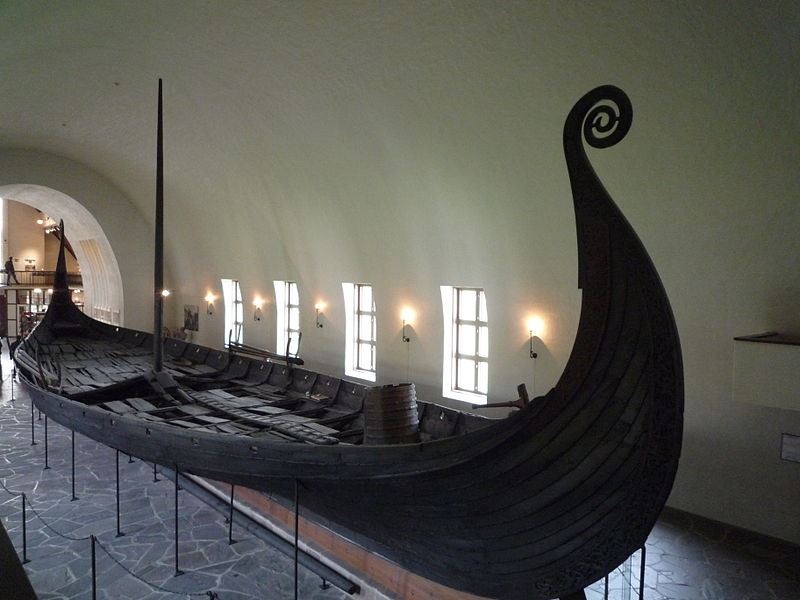
Viking Oseberg longship
Art does not operate in a vacuum and any artist at the top of their practice will look further afield and try something new when a formula produces the same old stuff over and over. Formula art belongs to the marketplace and dealers, not to artists driven by creative passion. It is no wonder that the Celtic artists adapted these styles and it is true that the Viking art styles were a breakthrough, totally outshining most styles before them.
In this Post I will share some features and characteristics of a few of the Viking art styles I have drawn in my journals so far. These examples have been adapted from the Celtic and Old Norse Designs pattern book by Courtney Davis.
The Viking art styles are categorised as:
- Oseberg/ Broa Style 750 to 800 AD
- Borre Style 830 to 970 AD
- Jelling Style 880 to 1000 AD
- Mammen Style 950 to 1060 AD
- Ringerike Style 980 to 1050 AD
- Urnes Style 1040 to 1150 AD
English archaeologist David M Wilson and Ole Klindt-Jensen have defined the Viking art styles in the survey work Viking Art, 1966. This analysis followed Haakon Shetelig’s study of ornate wood carvings which included the remarkable Oseberg ship burial.
There is an overlap in the features and characteristics in all six periods listed above. The Viking motifs and designs include animals real and unreal, plant fragments, and intertwined birds and figures in a knotwork of curved lines and elaborate patterns.
Broa Style Great Beast
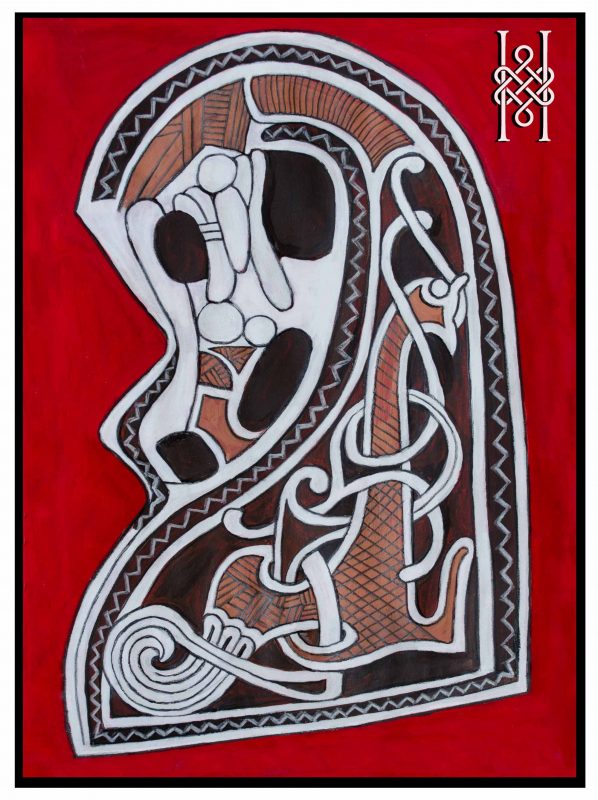
Great Beast Broa style
The animal in this design is not naturalistic and when the animal in Viking art cannot be identified it is called a great beast. Sometimes the animals look like serpents, dragons or monsters. In this drawing the tan animal has a small head in profile, a round bulging eye, small snout and small mouth and an open hip that becomes a triple tendril or plant fern style frond: all features that belong to the Broa period. There is curved line interlacing in loops and curls and there are tendrils extending into scrolls. A double contour line (white narrow band) accentuates the design shapes throughout and a decorative zig zag can be seen.
The design which is carved on a wooden bed post has freestyle abstract shapes in the upper left corner and uses strong contrasts of colour to balance the composition. Colours have been added to the original black-white drawing from the Courtney Davis drawing found in the book Celtic and Old Norse Designs.
The Broa and Oseberg were the first stage in Viking art and they overlap and share common features.
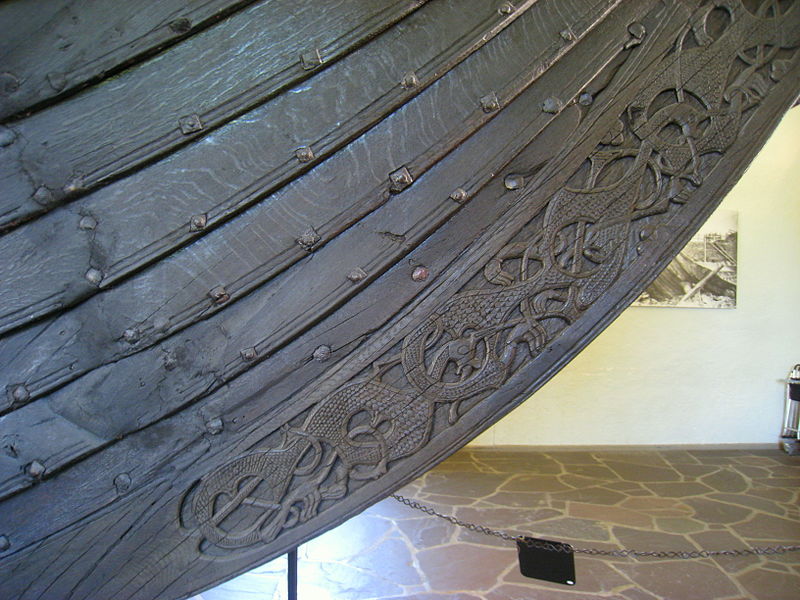
Oseberg Ship -Animal interlace carving
Oseberg Ship
The amazing and beautifully preserved oak Oseberg ship was found buried in a ship grave on a farm near Tonsberg in Norway. A treasure for history and art from ancient times.
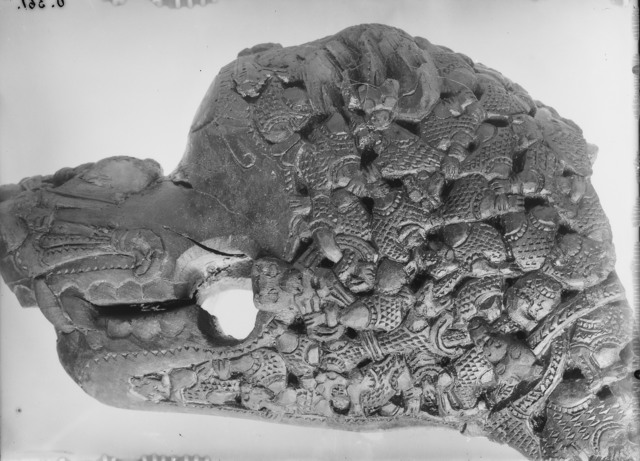
Gripping beast motif Carolingian head post
Accompanying this magnificent Viking longship were five carved animal head posts; the most famous of which is the Carolingian animal head post. It is decorated tightly with interlocking gripping beasts all over the head.
These amazing little gripping beast motifs are carved in wood. The little paws intertwine and grip the surrounding beasts or their own body in a network of activity. It is thought the Carolingian head could be the head of a wolf.
The carving on the Oseberg ship itself has animal interlacing in a flatter and more traditional style of curving lines and patterned animal shapes shown above in photo.
Gripping Beast
Detail from a Sledge Pole in Oseberg. This drawing shows the gripping beast in the flat (two dimensions on paper).
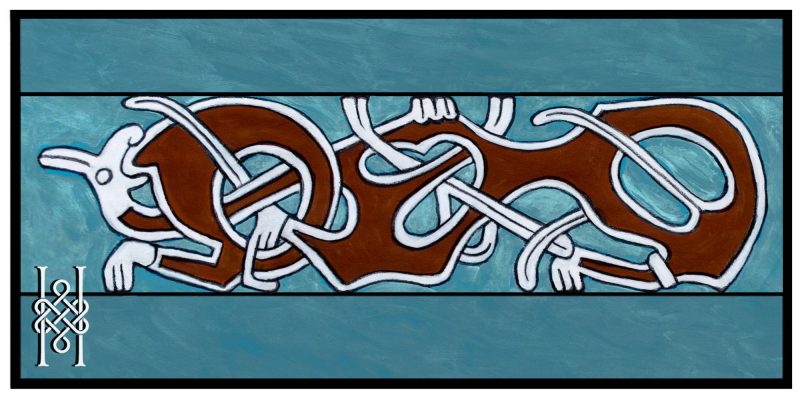
Gripping Beast motif shows paws
The Gripping Beast is an absolute stand out motif (not the best example shown here). It pioneered an outstanding breakthrough from earlier art styles, especially as represented on the Carolingian head post in three dimensions. The gripping beast appears in early Viking styles like Oseberg but also in the next Borre period. The paws grip or touch the border edges and the body. Again, there is a double contour line (white narrow band), the eye is a circle and the head is in profile. The flat band body has cut out shapes and legs, hands and tendrils that weave through the body openings.
The animal’s mouth is shown biting it’s own body. Maybe this is a symbol of a carnivorous mammal (Reference detail: Jonas Lau Markussen website on Viking Art). This remarkable feature of the gripping beast is also seen in the Mammen stage.
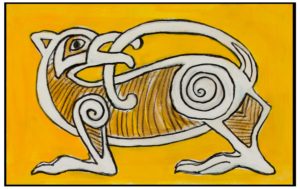
Mammen style. Animal bites his own tail.
The illuminated manuscript monk artists also liked the biting and gripping beasts of Viking art and adapted them to the Book of Kells in 800 AD. (Some Vikings after the terrible raids of destruction did settle in Ireland). Interlacing animals using the knotwork style were even included in the initials and the calligraphy.
Ringerike Great Beast
This Great Beast from the Ringerike style was found carved on a grave. What an extraordinary image from Viking art with both naturalistic and abstract qualities in the drawing.
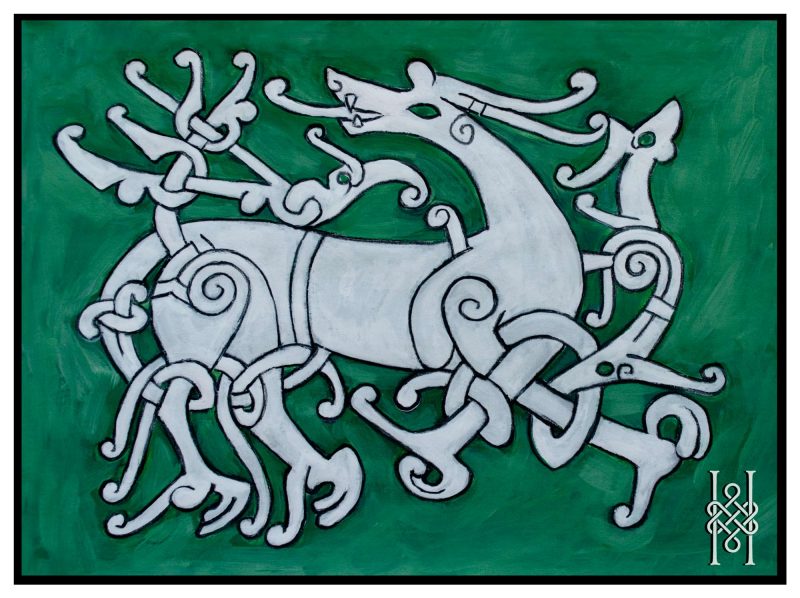
Viking Ringerike Great Beast
The Ringerike style developed from the Mammen period. Multiple tendrils in varying widths and in clusters were added. They swing outward and terminate in curling scrolls. The design is busy, alive and yet tight and there are no decorative marks like stripes on the body mass. This is a large beast with possibly two serpents- another added feature to the interlacing pattern. The spiral on the hip joints remains and teeth are added to the head which is again in profile. The feet seem to have a leaf like motif.
Somehow the animal seems to be moving and dancing despite the incredible attention to detail of the interlace. Tendril shapes seem to push the energy outward to the surrounding space and the frame.
Jelling Animal
This design is closer to the Jelling style of the 10th century. It is a style named after an animal motif found on a small cup in the royal burial mound at Jelling, Denmark. There is no gripping beast in the Jelling style, no biting or gripping with the mouth although sometimes the snout is extended into a knot and the mouth is open.
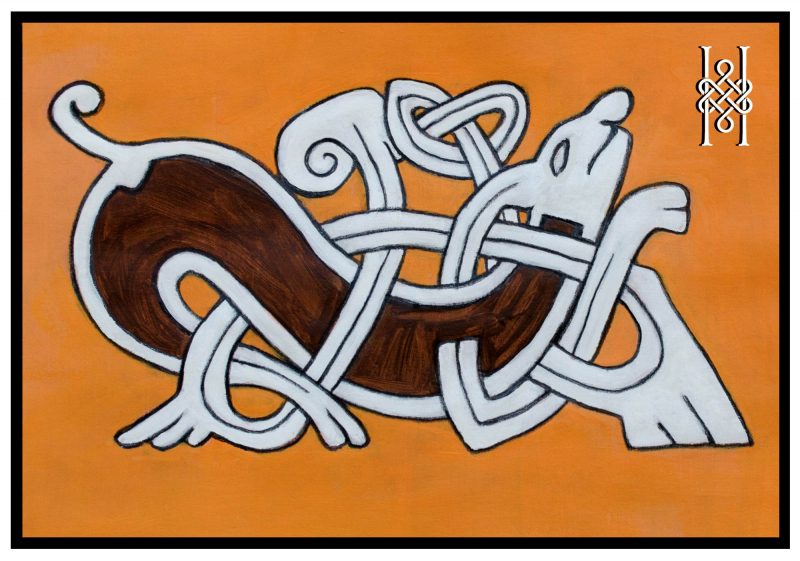
Viking Jelling style Animal
The profile head arches up sharply, the ear extends and becomes the leg and the body is band shaped. There is a knotwork pattern of interlocking and weaving again and what looks like a pretzel knot. The eye is almond shaped in this case and the animal outline is a double contour line while the weaving ribbons are split with a central line. Not sure if the lappet widening is paws or a decorative compositional device.
This particular design is drawn from a carved stone on the Isle of Man and taken from the Courtney Davis Celtic and Old Norse Designs booklet.
The Great Beast and the Gripping Beast clearly made a mark in early Viking art. The motifs have stayed around and today they are still like shining beacons on a significant period of art history.
On wood, metal and stone they have a resonance and joy all of their own.
These essays are from my own studies and are copyrighted by me. The artwork is adapted to illustrate the text and comes from Celtic and Old Norse Designs by Courtney Davis.
Colour has been added. Pages can be printed and used for educational purposes.
